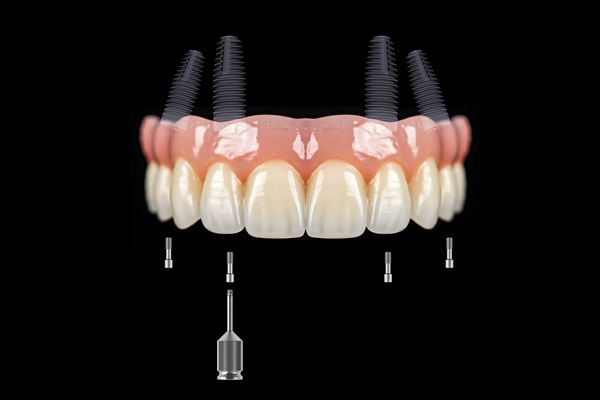How Long Does It Take to Get Implant-Supported Dentures?

You have probably heard about dental implants and how this tooth-replacement option can restore your smile. Dentures are another treatment that patients with multiple missing teeth can benefit from. Your dentist can also combine the two by providing implant-supported dentures. There are reasons that this method offers advantages over traditional dentures.
Implant-supported dentures vs. regular dentures
Both types of dentures come in partial and full varieties. Both also help restore the person’s smile and allow them to eat and speak normally once again. However, there are key differences between both of these treatments, including the following:
- Traditional dentures rest directly on the person’s gums
- Implant-supported dentures attach to titanium implants
- Patients can remove their own dentures
- Only the dentist should remove implant-supported dentures
Preparing to get implant-supported dentures
Patients who are interested in getting this treatment should first speak to a dentist, who can explain the procedure and the benefits and drawbacks of the process. If necessary, the dentist will remove any teeth that cannot be salvaged due to decay or other damage. The dentist will take X-rays and make impressions of the patient’s mouth and send this information to an off-site dental lab.
Putting in the implants
At the patient's next appointment, they will return to the office for implantation. First, the dentist will numb the patient with a local anesthetic to ensure they remain comfortable during the procedure. Next, an incision is made in the person’s gums, and the dentist will place the screw-like posts into the jaw.
Once the person’s mouth has healed and the jawbone fuses to the posts, the next step will occur. Here, the dentist attaches abutments to the posts. The dentist will then place the person’s dentures onto the abutments and will ensure that there is a comfortable fit.
The healing timeline
One of the possible drawbacks of getting implant-supported dentures is that the treatment process can be lengthy. Each individual appointment will take about an hour. However, the procedure and healing process occur over several months.
The dentist must wait until the patient’s gums and jaw have fully healed from the surgeries before moving on to the next step. The implants will also need to be fused with the patient's jawbone, ensuring a solid foundation for future dental restoration. This process is known as osseointegration. It can take six months or longer before the patient returns to the dentist to have their dentures placed.
Follow-up
Before the patient leaves the office with the dentures, the dentist may have to make adjustments. In the coming weeks and months, the dental staff will follow up with the person to make sure eating and speaking are not difficult. The dentist may also provide insight and education to help the patient take care of the implant-supported dentures. This includes proper brushing and flossing.
Schedule a consultation to say
Before you decide whether to get implant-supported dentures, you should understand how the procedure works. It is also important to realize that the process can be long, depending on your health and recovery from the surgeries. If you are interested in implant-supported dentures, call our Sioux Falls office today to schedule an appointment and start your journey toward a healthier and more confident smile.
Request an appointment here: https://www.1dentalwellness.com or call Dental Wellness at (605) 252-5955 for an appointment in our Sioux Falls office.
Check out what others are saying about our dental services on Google: Dentures and Partial Dentures in Sioux Falls, SD.
Related Posts
Dentures are removable, custom-made replacements for lost teeth. If you want your dentures to last for a long time, it is crucial to take care of them. This will help you to avoid a wide range of issues. Keep reading to find out more about proper denture care.There are different types of dentures that are…
For many people, dentures are an integral part of their daily lives, and their oral health can be very different when they have them in than when they don’t. That’s why taking care of your false teeth and maintaining excellent oral hygiene with or without them are key to improving your overall health and well-being…
Dental bridges can replace a section of missing teeth. They look and function essentially the same as natural teeth. If you are missing multiple teeth and are considering a dental bridge, then learning more about what it is exactly and who is an ideal candidate for treatment is helpful in determining whether treatment is appropriate.There…
Your cosmetic dentist can reshape your teeth to improve your dental health and appearance. This can even enhance your general health. Bonding material allows the dentist to provide you with a better dental shape. Here are the details on how a cosmetic dentist can reshape your teeth with dental bonding.A chipped edge and dental staining…
